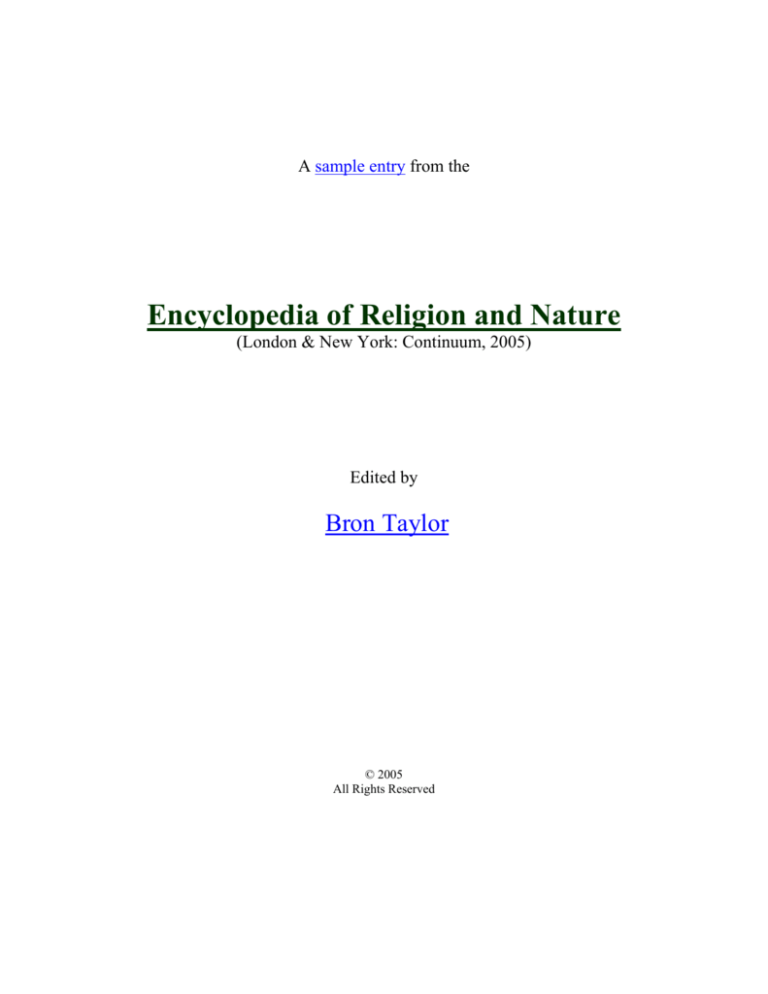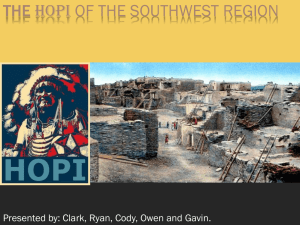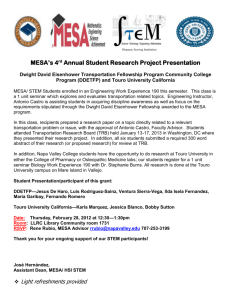
A sample entry from the
Encyclopedia of Religion and Nature
(London & New York: Continuum, 2005)
Edited by
Bron Taylor
© 2005
All Rights Reserved
Black Mesa
concerning the relation between Black Elk’s characterizations of traditional Lakota beliefs and religious rituals and
his acceptance of and participation in Christian religion.
Neihardt and Brown made no mention of Black Elk’s
Catholicism. In publishing the interview transcripts,
DeMallie (1984) discussed Black Elk’s life as a Catholic
catechist, and in telling her life story, Lucy Looks Twice,
Black Elk’s daughter gave her perspective on her father as
a Catholic religious leader (Steltenkamp 1993). A critical
literature has developed that attempts to disentangle
Christian and traditional elements from Black Elk’s
religious teachings. However, Black Elk can best be understood as an individual who spent his entire life seeking
religious knowledge to benefit his people. As a young man
he found it in traditional religion, and later, when he traveled in Europe, he found strength in Christian teachings.
After the failure of the Ghost Dance, Black Elk apparently
relied more and more on Catholic teachings until he
finally stopped the practice of traditional rituals
altogether. But this should not be confused with lack
of belief. Black Elk’s descriptions of Lakota religion
incorporated more and more Christian symbols and values
as his life progressed, revealing an increasing syncretism
of Lakota tradition and Christianity. In old age he performed traditional Lakota religious rituals for the edification of tourists, not merely for amusement, but to
demonstrate that there was goodness and value in the old
ways, different as they were from Christianity.
Raymond J. DeMallie
Further Reading
Brown, Joseph Epes, recorder and ed. The Sacred Pipe:
Black Elk’s Account of the Seven Rites of the Oglala
Sioux. Norman: University of Oklahoma Press, 1953.
DeMallie, Raymond J., ed. The Sixth Grandfather: Black
Elk’s Teachings Given to John G. Neihardt. Lincoln:
University of Nebraska Press, 1984.
Holler, Clyde, ed. The Black Elk Reader. Syracuse:
Syracuse University Press, 2000.
Neihardt, John G. When the Tree Flowered: An Authentic
Tale of the Old Sioux World. First published, 1951;
reprint edition, When the Tree Flowered: The Story of
Eagle Voice, A Sioux Indian. Lincoln: University of
Nebraska Press, 1991 (with a foreword by Raymond J.
DeMallie).
Neihardt, John G. Black Elk Speaks: Being the Life Story of
a Holy Man of the Oglala Sioux. First published, 1932;
reprint editions, Lincoln: University of Nebraska Press,
1961, 1979 (with a foreword by Vine Deloria, Jr.).
Steltenkamp, Michael F. Black Elk: Holy Man of the Oglala.
Norman: University of Oklahoma Press, 1993.
See also: Lakota; Lakota Sun Dance.
P
199
Black Mesa (New Mexico)
In the autumn of 1969, I spent a month in the Huichol
Indian village of San Andres de Coahimiata in a remote
region of the Sierra Madre Occidental of western Mexico.
I was conducting field recordings of Huichol music and
documenting their annual peyote fiesta, as well as their
construction of musical instruments. It was during
this time that I realized that traditional cultures are
endangered by the spread of industrial monocultures
whose paradigm is dominated by an economic imperative
and growth for its own sake.
On returning to the United States, I resigned as music
director for the Center for Arts of Indian America and
co-founded the Central Clearing House in Santa Fe, New
Mexico. The Clearing House was committed to gathering
and providing information about threats to the natural
environment occurring throughout the American Southwest. In early April 1970, National Park Service historian
Bill Brown informed me of a massive coal strip mine to be
situated atop Black Mesa, a land formation located in
northern Arizona bearing the largest coal deposit in
that state. Black Mesa is sacred to both Hopi and Navajo
Indians. The ancient Hopi villages are situated on the three
southern promontories of Black Mesa, a land form considered to be the body of the female mountain by the
Navajos.
Brown and I explored the surface of Black Mesa from
both truck and airplane. We learned that the coal
from Black Mesa was to be delivered to two electrical
generating stations, one to be located on the banks of Lake
Powell near Page, Arizona, the other already constructed
in Laughlin, Nevada.
Subsequently, I visited my old friend and Hopi elder
David Menongye who resided at Hotevilla on Third Mesa.
David had heard nothing of this and asked if I would speak
before an assembly of Hopi elders, to which I agreed.
Sixty-three elders gathered in the Second Mesa village of
Shungopovi in mid-April. I presented the few facts that
I had at my disposal. The Hopi Tribal Council chaired by
Clarence Hamilton, and represented by John Boyden, a
Salt Lake City attorney who served as the Hopi Tribe’s
legal counsel, had signed a lease. It allowed the Peabody
Coal Company of East St. Louis to strip-mine Black Mesa.
Coal would both be hauled by special railway to the power
plant at Page, and be transported by water drawn
from wells tapping the ancient Black Mesa aquifer, then
pumped through a slurry pipeline for 273 miles to the
Mojave power plant in Laughlin.
The coal commanded a very low price, and the Hopis
were to be paid $1.67 an acre foot for some of the purest
water in America. Three acre-feet is the equivalent of
approximately one million gallons, or a one acre pool
three feet deep. This water was to be pumped at the rate of
two thousand gallons per minute, twenty-four hours a day.
200
Black Mesa
The traditional Hopis were enraged that these negotiations had taken place without their knowledge. Many of
these elders spoke little or no English. After a discussion,
David Menongye asked if I would help serve as a bridge to
the world of the Bahannas, or white people, to end this
mining, which violated the Hopi’s spiritual relationship to
Mother Earth. I agreed, and on 17 April 1970, my friends
Jimmy Hopper, Bill Brown, John Kimmey and I founded
the Santa Fe chapter of the Black Mesa Defense Fund. We
were soon joined by Terrence Moore, Philip Shultz, Caroline Rackley, Tom Andrews, Hannah Hibbs and a host of
volunteers. For the next three years, we did everything in
our power to stop what we considered to be the rape of
Black Mesa, but to little avail. We worked closely with the
Native American Rights Fund of Boulder Colorado, a law
firm devoted to serving Native Americans. We also worked
with traditional Navajos and many others throughout
the American Southwest and beyond to try to thwart the
juggernaut of corporate America as they ravaged the
land making every attempt to convert Black Mesa into
money.
Research revealed that the underlying purpose for the
Black Mesa strip mine was to fuel the Navajo Generating
Station capable of a 2000 megawatt generating capacity.
About 25 percent of this electricity was to be used to pump
water from Lake Havasu downstream on the Colorado
River to the central valleys of Arizona. This massive public
works project is known as the Central Arizona Project
(CAP). The water was ostensibly to be used for agriculture,
but over time became far too expensive for farmers, and is
now used for development in Phoenix and Tucson.
It should be recalled that the original proposal for
supplying the electrical needs for the CAP would require
that two dams be constructed near either end of the Grand
Canyon to generate hydro-electric power. David Brower
and the Sierra Club called on the American public, and
public opinion indeed thwarted the proposed dams. The
obvious alternative was to mine coal from Black Mesa to
fuel the Navajo Generating Station near Page, Arizona.
In the meantime, traditional Hopis were being represented in the world at large by Thomas Banyacya with
whom I traveled throughout the United States on speaking
tours wherein Banyacya revealed his interpretation of
the Hopi prophecy of coming disaster in the face of “the
march of progress.” In his lecture, Banyaca referred to a
cloth rendering of the ancient petroglyph situated near
Old Oraibi that bespeaks of the Time of Purification. The
rendering portrayed the tools given to the Hopi by the
Great Spirit, Massau. This was followed by two roughly
parallel paths. The upper path was that of the White Man
and revealed two white men and one Hopi that had
assumed the ways of the White Man. This path finally
peters out. The lower path reveals the way of the traditional Hopi and is strong and enduring. Both World Wars I
and II are represented, as is the coming of World War III
followed by the time of purification. Banyacya said that
the White Man was doomed because of his faith in technology over that of the way of the Great Spirit. Only those
would survive who followed the traditional Hopi way and
the path of the Great Spirit.
In my own lecture, I spoke of the necessity for understanding the facts surrounding the strip-mining of Black
Mesa, and attempted to rally university students to protect
endangered environments using whatever means were
available short of harming fellow humans. I called the
Central Arizona Project the perfect model of total
environmental degradation, which included:
• the polluting of aquifers with seepage from strip-mined
Earth;
• devastation to landscape through massive strip-mining
of coal;
• marring of landscape by the construction of the coalbearing railroad across the once pristine Kaibito
Plateau;
• the befouling of the air of the American Southwest with
smoke emanating from the coal-fired power plants;
• the depleting of the Navajo aquifer beneath Black
Mesa;
• the march of the electric powerlines extending from
Page to Lake Havasu;
• providing water from the Colorado River to Phoenix
and Tucson, cities located in the fragile ecosystem of
the arid Sonoran Desert.
All of this would result in the utter disruption of both
Hopi and Navajo traditional cultures which would bear the
brunt of devastation to air, land and water in their sacred
homelands in the heart of the Colorado Plateau.
In early 1971, my wife Katherine and I were invited by
traditional Hopis into the kiva, or subterranean sacred
ceremonial chamber at Hotevilla on Third Mesa. Present
were twenty or so male elders including David Menongye,
Thomas Banyacya and John Lansa, husband of Mina
Lansa, then the kikmongwi or traditional leader of Old
Oraibi. Throughout the day, they related their collective
point of view, which they asked me to write down and
publish. The following two quotes are excerpted from
what was published in Clear Creek Magazine in 1972:
The Black Mesa area is a sacred place. The Hopi
knew it to be the spiritual center of the whole continent that contained the heart and soul of the
Earthmother. The Great Spirit had granted them
permission to live in that sacred place, to pray for
balance and harmony, and to live within the life
plan that the Great Spirit had taught them. The Hopi
people still live there in the Black Mesa area, and the
traditionalists still follow the teachings of the Great
Spirit.
Black Mesa
The Hopi look to the Earthmother for food and
nourishment, for it was from the womb of the
Earthmother that the Hopi and all living creatures
emerged in the beginning. The animals and plants,
the eagles and people are all kept alive through the
power of the flow of Nature. The inter-action
between all living things – the relation of rocks to
the land, the flow of water, the dance of yellow
butterflies in the cornfields – all this marks the
balance of Nature.
The Hopis are stewards of the land. In their kivas,
they perform rituals and ceremonies so that Nature
will work in balance with people. These ceremonies
are reflections of the teachings of the Great Spirit,
which the Hopi received at the time of emergence
from the lower world. They achieve a state of
mind through which they perceive that those early
beginnings and the present are all the same, that
time is not just a linear passage from the past to the
future, but rather a continuum in which the annual
cycles with their ceremonial events touch each other
in reaffirmation of meaning.
In the words of Hopi elder John Lansa as translated by
Thomas Banyacya,
There is a spiritual seeing of things that can’t be
explained. There are shrines in the spiritual center,
which are markers for spiritual routes which extend
in all four directions to the edge of the continent.
Through our ceremonials, it is possible to keep the
natural forces together. From here at the spiritual
center, our prayers go to all parts of the Earth. Our
prayers maintain the balance that keeps all things
well and healthy. This is the sacred place. It must not
have anything wrong in it. It must never be defiled.
We want it organic the way it has always been.
Leave the land in the hands of the Hopi to take care
of everything for all the people. We know how to
farm. Only people who know how to grow things
will survive. Through prayer, people can develop in
their own way as the Hopi have.
On the one hand, Black Mesa was seen as an enormous
coal deposit, the strip-mining of which would result in
great economic gain to resource extractors, land developers, politicians, and other corporate beneficiaries. On the
other hand, the sacred heartland of an ancient traditional
culture was to be utterly desecrated and defiled. The
Hopi deity Massau was in direct conflict with Mammon,
the hidden deity of corporate America over the fate of the
precious landscape of the American Southwest. A hidden
villain in this scenario was the Hopi’s general counsel,
John Boyden who was suspected of and later revealed to
be quietly representing the Peabody Coal Company of East
St. Louis at the same time.
201
Within their cultural milieu, the Hopi are sophisticated
and knowledgeable with regard to subsistence farming in
one of the continent’s most arid landscapes. Hopi spirituality and ceremonial practices help them remain aligned
with the seasons and allow them to recognize that which is
sacred within the flow of nature. The presence of the Black
Mesa mine has greatly disturbed the natural balance of
both Hopi culture and the ecosystem.
In the spring of 1972, David Menongye, Thomas Banyacya, two younger Hopis, Katherine and I were scheduled
to attend the first United Nations Conference on the
Human Environment in Stockholm, Sweden, in an attempt
to bring the Black Mesa debacle to global attention. The
Hopis had refused to secure United States passports on the
grounds that they were citizens of the Hopi Independent
Nation, not the United States of America. My wife and I
fashioned passports bound in tanned deer hide that bore
the inscription, “The bearer of this passport is a citizen
of the Hopi Independent Nation. This passport is valid as
long as the Sun shines, the water flows, and the grass
grows.” David Menongye blessed the passports with corn
pollen and affixed an eagle feather to each one. It took
a fair amount of time at LAX, but finally a pilot from
Scandinavian Airlines agreed to take us to Stockholm.
Ultimately, the passports were stamped by Swedish
authorities, thus validating them in the eyes of international bureaucracy. They were later stamped in
Denmark.
In Stockholm, Hopis and Navajos met with members of
other traditional cultures from around the world establishing a network that continues to today.
But the strip-mining of Black Mesa was begun and continued into the twenty-first century. Water continues to be
pumped out of the Black Mesa aquifer. A new generation
of Hopis and Navajos use every legal means at their disposal to thwart this pumping as Hopi springs and Navajo
wells run dry. This environmental catastrophe now fosters
growth in the major cities now located in the Sonoran
Desert, a fragile landscape ill-prepared to absorb so many
humans. The Central Arizona Project, originally conceived
as an irrigation project, has become the means by which
population centers in Arizona continue to metastasize
over the land.
In the meantime, Hopi and Navajo culture-bearers fight
so that their home habitat and their spiritual values may
survive.
The human species is an invasive species. The mining
at Black Mesa has many parallels globally. Traditional
cultures that have evolved within habitat are gravely
endangered by invading outsiders intent on extracting
non-renewable resources located in homelands native to
others. Peoples whose sensitivities and sensibilities are
finely honed to home habitat are being displaced not only
by extractors, but more also by the dominant monoculture
which attempts to reeducate people native to place into a
202
Blackfoot Cosmos as Natural Philosophy
paradigm commensurate with that of the more dominant
culture. Thus cultural diversity is disappearing. As cultural
diversity and its attendant affiliation with the spirit of
place disappear, the intuitive ability to perceive the sacred
quality of the biotic community seems to atrophy. Finally,
the perception of reality is restricted to a “nuts and bolts”
point of view that excludes the mystery, the numen, the
meaning.
Imagine a collaboration between indigenous peoples
whose understanding of native habitats is contained
within their lore, music and ceremony, and biological
scientists who well understand that extermination of
species tolls the knell for habitat. Imagine thinking in
terms of watershed boundaries rather than geopolitical
boundaries. Or that the Earth is a living organism rather
than a body of real estate to be divided among the most
powerful humans. Or that we are honored to be members
of the biotic community of our planet Earth rather than
considering ourselves to be dominant and separate. The
result could combine knowledge and wisdom of specific
homelands in such a way as to foster reciprocity between
humanity and habitat, and thus reinvoke the Spirit of
Nature in our daily lives.
Jack Loeffler
Further Reading
Moving Waters: The Colorado River and the West. A sixpart radio series produced by Jack Loeffler for distribution over National Public Radio. Arizona Humanities
Council, Phoenix, Arizona, 2000.
Sturtevant, William C. and Alfonson Ortiz, eds. Handbook
of North American Indians, vol. 9, Southwest.
Washington: Smithsonian Institution, 1979.
Waters, Frank. The Book of the Hopi. New York: Viking,
1964.
Wilkinson, Charles. Fire on the Plateau: Conflict and
Endurance in the American Southwest. Covelo, CA:
Island Press, 1999.
See also: Abbey, Edward; Brower, David; Earth First! and
the Earth Liberation Front; Holy Land in Native North
America; Hopi–Navajo Land Dispute; Hopiland to the
Rainforest Action Network; Indigenous Environmental
Network; Law; Religions and Native American Lands;
Radical Environmentalism; Snyder, Gary.
Blackfoot Cosmos as Natural Philosophy
Our ancestors were strong, powerful and were well
equipped with survival skills. They taught us to live
in harmony with nature, the animals and the birds.
They taught us that the land belongs to the Creator
and that we belong to Mother Earth. Our legends
teach us lessons (Rufus Goodstriker (Piinakoyim) in
Zaharia and Fox 1995: 97).
The group of closely related nations of the Algonquin
linguistic stock known as the Blackfoot Confederacy is
comprised of four divisions: the Southern Piegan, or
Blackfeet, of Montana; the Northern Piegan, or Blackfoot,
of Alberta; the Kainah, or Bloods; and the Siksika, or
“Blackfoot” proper. Loosely organized in mobile social
units described as “bands” in the anthropological literature and relying on the buffalo as its economic base, the
Blackfoot Confederacy controlled a vast terrain stretching
from northern Alberta and western Saskatschewan in
Canada down into the high prairies of Montana in the
United States. In 1833, their numbers were estimated to
be nearly twenty thousand people (Maximilian 1906).
Devastated by epidemics and unequal military struggle
with colonial powers, the Blackfoot Confederacy suffered
a steep demographic decline at the turn of the twentieth
century, which was partially offset by a gradual postWorld War II population increase that brought the confederacy’s numbers to about fifteen thousand enrolled
members in 1990. Deprived of a bulk of their territorial
possessions, the present-day Blackfoot resist a high
unemployment rate, lack of proper medical care and
bureaucratic interventions through an intensive focus on
communal values, personal integrity, local knowledge,
and cultural revival, including that which represents a
strengthening of the Blackfoot philosophical universe.
Throughout the world, Native peoples seek to be aware
of, in communication with, and hopefully synchronized
with, the rhythms of the natural world. In the Blackfoot
context, spiritually “knowledgeable” or “powerful” people
are those who know how to do this. The purpose and structure of stories, teachings, and practices emphasize this
point. Mokakssini, the Blackfoot word that approximates
epistemology – referring also to notions of awareness of
total being, and knowing – is founded upon deep knowledge of the environment, the cosmos, and all of life, and is
rooted in spirituality. Blackfoot teachings consider humans
to be part of a delicate harmonious relationship with both
the Earth and the heavens, wherein the Sun, Moon, the
planets and stars – called Spumatapiiwa (“Sky People”) –
have spiritual as well as physical properties. The natural
harmony of the Blackfoot universe is easily disrupted unless
humans remember their responsibility to maintain it.
The spiritual practices that are related and relayed to
humans in Blackfoot stories hold valuable lessons for
seeking deeper knowledge via awareness of the interrelationships between humans and the rest of their
environment. Preparations to increase one’s awareness
during a vision quest or by participation in the Sun Dance,
for example, are not simply about the preparation of
the mind (i.e., psychological), but rather to bring into
harmony, to synchronize the whole human, with the
“whole,” the “multiverse.” Blackfoot vision traditions are
central awareness-seeking sources contributing to the rich
body of Blackfoot knowledge. This tradition survives as








